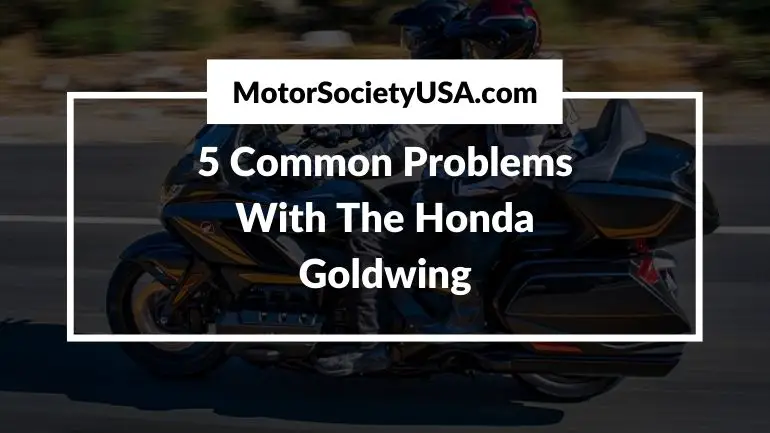When you think of comfortable touring motorcycles, you think of the Honda Goldwing. Since its inception in 1974 the Goldwing has been one of the most iconic touring motorcycles. It is an excellent option for riders looking to put on the miles in comfort and style.
The Goldwing comes standard with a flat six cylinder engine that makes an impressive 126hp. The power arrives at the rear wheel via a shaft drive. Shaft drives are perfect for touring bikes due to their durability and low maintenance.
Although the Goldwing is an excellent motorcycle, there are some things you should be aware of and watch out for when shopping for and test riding these motorcycles.
1. Honda Goldwing DCT Phantom/Ghost Clutch
The top of the line Goldwing comes standard with a DCT (Dual Clutch Transmission). While some riders love this transmission, its not for everyone. The type of transmission is more of a personal preference, but some riders dislike the DCT and nicknamed it the “Ghost” clutch.
The problem is that the DCT is computer operated and motorcyclist used to hand clutch levers often find themselves reaching for a clutch lever that doesn’t exist. Despite this, many owners are shocked to find that the DCT seems to shift right when they are reaching for the clutch lever that doesn’t exist.
The second issue that owners take up with the Honda Goldwing is that the DCT can be somewhat “clunky when decelerating and accelerating. A calibrated throttle hand is required to keep the 126 ponies in the Goldwing under control at low speeds.
Honda has attempted to remedy this by adding adding a “creep” gear that is actually the electric motor in the reverse gear. The electric motor is able to push the bike forward very slowly. This feature is activated by a push button on the left handle bar.

2. Difficulty Accessing Motor For Maintenance
Many motorcyclist like doing their own routine maintenance. But it can be hassle if you have bodywork that needs to be removed to access key components. The Goldwing does suffer from this. In fact you even have to remove a plastic cover to access the dip stick so that you can check your oil level. Other plastic body work does get in the way of routine maintenance.
3. Sticky Handlebar Switches
Thankfully this is a straightforward problem with an easy solution. But since it is such a widespread criticism we thought we’d include it on our list. Goldwing models use many push-on/push-off buttons on both handlebars. These buttons control cruise control, hazard lights, and audio mute.
The shaft connecting the buttons to the inner switches is greased internally. The problem is that this grease can pick up dust and dirt over time. These contaminates eliminate the lubrication benefit provided by the grease, and in fact it can turn the grease into more of an adhesive than a lubricant.
The button will press in to turn on without issue, but when attempting to press in to turn the button off the button can get stuck. Basically the spring inside the switch is no longer powerful enough to overcome the grease which has turned into glue, and the result is the owner can’t turn the function off.
The solution is simple. An electrical contact cleaner is the solution. We recommend using a quick-drying contact cleaner to avoid leaving any residue. WD-40 is not recommended, although you may have some luck with it for a short period of time.
4. Blocked Secondary Master Cylinder (Recall)
This problem seems to occur in Gold Wings from the 2000s, and the issue is most common on motorcycles that don’t regularly have brakes serviced. This can be a problem if you are looking to purchase a used Gold Wing as many motorcycles don’t have a lot of miles or maintenance on them depsite their age.
The problem occurs when the check valve opening of the second master cylinder becomes clogged by brake fluid contaminates. When the motorcycle rider squeezes the brake lever, the brake fluid pressure increases.
This rise in pressure can jam the check valve. The stuck check valve can’t relieve pressure. This causes the brakes to stay on even when the brake lever is released.
This brake drag can be very dangerous for a motorcyclist as it makes the bike unpredictable and increases the risk of crashing. It will also wear out your brake pads, rotors, and maybe even damage the calipers.
The affected models include the 2001-2010 and 2012-2015 GL1800 Gold Wings, 2001-2005 GL1800A, and 2013-2018 GL1800B. So if you’re in the market for one of these bikes, check the VIN with a local Honda dealer to see if it is one of the recalled motorcycles and if the secondary master cylinder has been replaced.
5. Cracked Frames (Recalled 2002-03 GL1800A)
This issue is mostly tied to Gold Wings in the early 2000s. So again if you’re in the used market this is an issue you need to be aware of.
The problem is found on the 2002-2003 GL1800A Gold Wings. The issue is due to an out of compliance weld on a lower cross member of the frame.
The problem is that the weld could crack and fail. The solution is that Honda will add extra TIG welding to the welds at risk.
This is definitely an issue that you’ll want to address right away if it hasn’t been already. The rigidity of the frame has a huge impact on how predicable the handling of your motorcycle is. Once the frame has been properly welded, these Gold Wings make excellent touring motorcycles.
If you liked this post, be sure to check out our other posts in this series including common problems with the Kawasaki Ninja.




